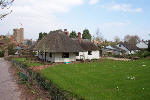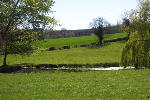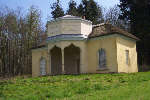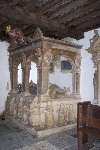The Village lies hidden in a sheltered spot on the edge of the Quantock's. Although only 3 miles from Bridgwater, it appears to exist in another time, a time when the horse and cart were the main method of transport.
To approach the village you go down small narrow twisty lanes. This is a close focused village of pretty, well maintained cottages. The main street has its streamlet, which once fed a number of ornamental lakes attached to the great mansion of Halswell House.
The village name could mean Goat-wood as Hurst is known as the Saxon word for wooded hill, or it could come from one of the manor family names. The reference in the Domesday Book refers to Gahers and in 1166 there is a reference to Hugh, son of Malgar de Gahers. By the 16th century the village is called Gathurst. The correct pronunciation that villagers use is Go-thurst.
The Kemeys-Tyntes family, who became the owners of Halswell Manor in the 18th century, changed the village quite dramatically. They bought up many of the local farms called in the leases on others so as to remodel the estate around Halswell House. The village became an estate village with the majority of inhabitants working on the estate and living in tithed accommodation. This lasted until the 1950's when the estate and many of the properties in the village were sold. This, perhaps, is why over two-thirds of the houses in the village were in existence prior to 1900 and so the village retains an olden English charm.
Unfortunately the village no longer has a shop or post office, the local village school was closed in the 1950's, and there is not a inn or ale house to be seen. The village hall is well used and the village has a lovely community spirit, there is a warm welcoming attitude towards visitors.
Halswell House
One of the legends that surround the families who have lived in the house is that of the first Tynte who, as a young knight of the Arundel Family, went on crusade with King Richard the Lionheart. He was singled out for his bravery at the battle of Ascalon. The King observing him is supposed to have said:
" .. the maiden knight had borne himself like a lion, and had done work enough for six crusaders"
For which service to the Christian cause the King conferred on the young Knight his armorial bearings (Heraldic device), a lion argent on a field of gold between six crosslets of the first and the motto "Tynetus Cruore Saraceno". Examples of the Tynte family crest can be seen in the church of St Edwards in Goathurst, and the inn The Tynte Arms in nearby Enmore.
Halswell House was rebuilt in 1689 by Sir Halswell Tynte and, at the back of the house, what remains of the Tudor manor house is 0. It is still a very imposing building with a number of interesting features, Nicholas Pevsner has described it as:
"the most important house of its date in the country."
Sir Charles Kemeys -Tynte remodelled the west front when he inherrited the House in 1740, using the designs of Francis Cartwright. The building suffered a major fire in 1923 and had careful restoration work carried out which cost £41,534. During the war the part of the house was the home to a girls school from Essex. The school found the buildings not suitable and moved to another property in the area. Part of the parkland then became a prisoner of war camp for the rest of the war years.
The contents of the house were sold in 1948, and the house in 1950 when the rest of the estate was auctioned. Part of the house was converted into flats. In 1985 it was again sold and some restoration work was carried out, it was then owned by Gramham Bond of Dunster Holdings,who spent the 2 years restoring the house, which was opened in 2007 as a wedding venue. That enterprise went bankrupt and, in December 2013, it was bought by businisseman Edward Strachan with the intention of making it his home.
Sir Charles Kemeys - Tynte was responsible for the changes in the estate in the 18th century. Prior to this date there had been a number of small farms and holdings, according to a survey in 1597 there was 204 acres with 57 enclosed fields. The largest field was Royal Meadow, which was 20 acres, over half the fields were below 4 acres the scene was of a patchwork of fields, meadows woodland and pasture. This was all charged by Sir Charles, who wanted to create his own pleasure gardens, for the fashionable landed gentry this was all the rage. He set about buying up local farms to increase the parkland surrounding his newly enlarged modernised house. He built follies and ornamental lakes the pleasure gardens at the time must have been quite a sight. Arthur Young writing in 1768 gives a description of the park just after it was completed:
"What chiefly attracts the notice and attention of strangers are the decorated grounds. The riding which leads to the principal point of view crosses the park from the house, commanding a fine view of the rich vale of Bridgwater. It then runs by the side of a woody precipice and up through some new plantations, from a dark part of which you entre through a door into a temple dedicated to Robin Hood; upon which a most noble prospect breaks at once upon the beholder. The ground shelves from it in front and to the right gradually, but to the left in bolder slopes where the dips are beautifully grouped with woods, and the hills above them rise in waving enclosures. As we advance the character of the ground changes most happily. A break through the trees to the right lets in a view of the rotunda. Passing to the Ionic portico, which is excellently placed, the scenery in view is truly enchanting: the lawn is gently waved; the water seems to fall naturally through a falling vale; and a swelling hill crowned by the rotunda forms a complete picture. The whole scene is really elegant; every part is riant, and bears the stamp of pleasure."
In the 1840's the grounds at Halswell House became the main place of relaxation for the local people of Bridgwater and surrounding villages,many visited on their days holiday. As the then owner Colonel Tynte, Member of Parliament for Bridgwater would open his grounds to the public.
"The main place of resort was Halswell House the home of Colonel Tynte. The grounds surrounding being very beautiful…, and was a favourite spot for picnic parties."
(A Bridgwater Diary by Philip J Squibbs)
The Temple of Harmony and Other Follies
The famous Temple of Harmony and Robin Hoods Hut have been restored to their former beauty in the 1990's after many years of neglect; this was when the Halswell Park Trust was created. The Trust's aims were to acquire more land so as to restore some of the beauties of the Halswell Park, they have been able so far to restore just the Temple and Robin Hoods hut, both these buildings are worth a visit. The Temple now stands in the open no longer surrounded by stately woods. From the Temple you can see what remains of Mill Wood with its ornamental fishponds and statues of nymphs. It is the Trust's dearest wish to be able to restore this part of the gardens but the great expense means that at present it must remain a number one priority on its wish list.
The Temple can be seen from the Goathurst to Enmore lane where there is a small lay-by next to some steps. The temple is only open on Sundays and Bank Holiday Mondays but you can wander round the building whenever you want. The original statue of Terpsichore was designed by Robert Adams and is in the county Museum there is now a copy in the temple.
To get to Robin Hood Hut you have a bit more of a walk but it is certain worth the effort. To visit the Hut you need, to follow the Drive leading to Halswell House, easy to spot as there is a picturesque thatched lodge at the entrance to the drive. Walk up the drive and just before House on the right you follow a path round the side of the woods and across a couple of fields, over a stile into a small wood - please keep to the path. Follow the path to the left, the entrance to the hut is on the left through the trees. Here you see the back of the Hut which looks like a thatched country cottage, as you walk round the building the view is just as splendid now as when Arthur Young first saw it in the 18th century.
One other of the Halswell Folly's also has been restored but when it came up for sale in 1996 the Trust were outbid. The Temple of Pan and barn were brought for £168,000 by a property developer and is now part of a private four-bedroom house.
St Edward's Church
The Quantock's are blessed with some beautiful churches and St Edwards is certainly one of the most interesting. The church's dedication is unusual, to St Edward, King and martyr. This young Saxon King was murdered by his stepmother Elfrida in 978 at Corfe in Dorset in order that her own son would become King. This suggests that there was a church on this site before the Norman Conquest.
The present building is mainly of the Perpendicular period and dates from the later part of the 15th century. The tower is older and was built in the 14th century, as it is a simple construction with rich mouldings around the archway. The church was restored in 1884 at which time the squint between the Tynte Pew and Chancel was discovered.
On the belfry walls under the tower there is a fine collection of Hatchments commemorating the Kemeys-Tynte family of Halswell House. These were hung above the front door of the House when a member of the family died for a month before being placed in the church. The deceased's side of the coat of arms was painted black. These hatchments, which were found in the Almshouses and placed in the church in 1910, are of 18th century date. Also to be seen in this area on the north wall is a painted panel, which again dates from the 18th century, the figures are of King David, the four evangelists together with a lady playing a harp. The panel possibly formed part of the western gallery for choir and instrumentalists.
The south aisle was the cause of some friction between the Halswell and Paulet families in the 16th century which required arbitration by a 'mediacion of friends'. They signed an agreement which gave the Paulets the south aisle and a plot of land north of the Chancel to Sir Nicholas Halswell so that he could build a chaple for himself and his heirs.
The Halswell chaple is found on the north side of the chancel behind red curtains. Here there is a splendid monument to Sir Nicholas Halswell and his wife Bridget, their effigies are surrounded by kneeling figures of their 9 children, 6 sons and 3 daughters. Sir Nicholas, as a Justice of the Peace, had a certain John Gilbert (alias Gogulmere) committed to prison. Gilbert was a fanatical minister who had attempted to preach naked in North Petherton church - an early Naturalist! In the chapel are other monuments to the family who had such a strong influence on the village of Goathurst.
If you want to know more about the church there is an interesting leaflet which gives a history of the building and explains in more detail about the monuments to be found in the church and in the church yard, written by R. D. Ansedell.
Bibliography
Legends of the County of Somerset, By C H Poole
The Goathurst Millennium Book, Editor Jo Silby
Buildings of England -South & West Somerset, N Pevsner 1958
A Bridgwater Diary, by Philip J Squibbs
External sites about Goathurst
- British History Online
Links straight to Goathurst entry. Scroll past the footnotes to find even more information. - Halswell Park Trust
The Halswell Park Trust, a registered charity, was formed in 1996 following the restoration of the Temple of Harmony an 18th century folly standing in the corner of Mill Wood - Office For National Statistics (ONS) detailed data
Detailed Goathurst parish data - if no data available at parish level links are provided to data at ward and local authority levels. - Office for National Statistics (ONS) summary data
Summary statistics for a slightly larger area around Goathurst. - top of page













